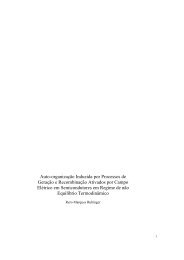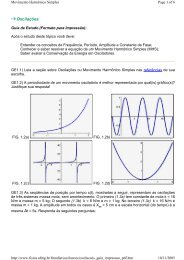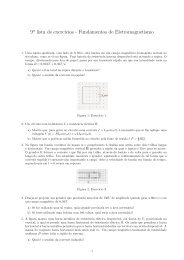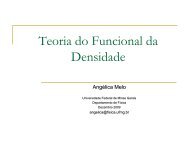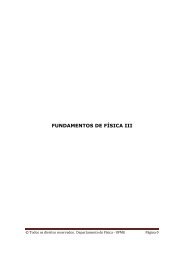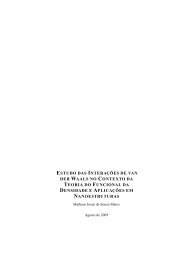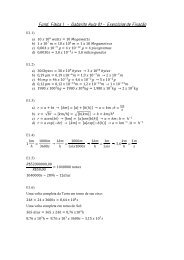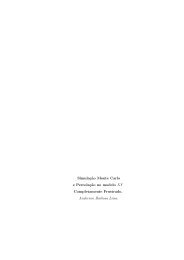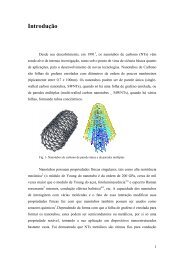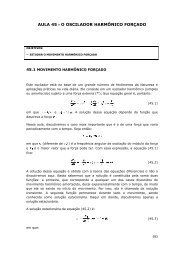Phase diagrams of a two-dimensional Heisenberg antiferromagnet ...
Phase diagrams of a two-dimensional Heisenberg antiferromagnet ...
Phase diagrams of a two-dimensional Heisenberg antiferromagnet ...
You also want an ePaper? Increase the reach of your titles
YUMPU automatically turns print PDFs into web optimized ePapers that Google loves.
B.V. Costa, A.S.T. Pires / Journal <strong>of</strong> Magnetism and Magnetic Materials 262 (2003) 316–324 323procedure does not work. Making use <strong>of</strong> thetranslational invariance <strong>of</strong> the system we maydefine the Fourier transformsGðq; oÞ ¼ X m;n0S þ n ; S m Teiqðn mÞ ; ð28Þin terms <strong>of</strong> which Eq. (27) becomesGðq; oÞ ¼ /Sz S 1p o oðqÞ ; ð29ÞwhereoðqÞ ¼8/S z S½Jð1 g q ÞþD eff Š; ð30Þis the magnon energy spectrum and g q was definedin (9). Using the relation/ABS ¼ lime-0iZ þNNGðo þ ieÞ Gðo ieÞdo;expðboðqÞÞ 1ð31Þwe find the following expression for the magnetization:1/S z S ¼ S Z ð2pÞ 2 coth boðqÞ dq 2 :ð32Þ2Near the critical temperature, where /S z S goes tozero, we can expand the argument in the integraland obtain1¼ 1 Z1 d 2 qT c 4S 2p 2 : ð33ÞJð1 g q ÞþD effPerforming the integral in the q y variable, we find1¼ 1 Z1 pdq xq ffiffiffiffiffiffiffiffiffiffiffiffiffiffiffiffiffiffiffiffiffiffiffiffiffiffiffiffiffiffiffiffiffiffiffiffiffiffiffiffiffiffiT c 4JS 2p 2 ; ð34Þ0ð2 þ B cosq x Þ 2 1where B ¼ 2D eff =J: For B small we can solve theintegral analytically and obtain1¼ 1 T c 4JSp ln p : ð35ÞBBefore interpreting the data for Rb 2 MnF 4 let usapply Eq. (34) to <strong>two</strong> other compounds [22]. ForK 2 MnF 4 we have J ¼ 8:4K; D ¼ 0:134 K whichleads to T c ¼ 42:73 K: The experimental value is42:3K: The second compound is MnðHCOOÞ 2 2H 2 O: We have J ¼ 0:70 K; D ¼ 0:0114 K: Wefind T c ¼ 3:57 K; to be compared with the experimentalvalue 3.68 K. Just for comparison, thequantum SCR gives T c ¼ 42:19 K and T c ¼ 4:09 Krespectively. For Rb 2 MnF 4 ; if we take D temperaturedependent, using for D the effective anisotropydefined in Eq. (2) with H sf given by Eq. (22)and calculate T c using Eq. (34) we obtain T c ¼40:53 K: Otherwise using the temperature independentvalue for the anisotropy, D ¼ 0:148 K; wefind T c ¼ 38:73 K; to be compared with theexperimental value 38:4K:In the Ising region are seen deviations from thecalculations. This can be attributed to the destruction<strong>of</strong> the pure planar anisotropy in the high fieldphase. The 2D XYphase is extremely sensitive tosymmetry breaking interactions and to the interplanarcoupling. Any <strong>of</strong> these effects move thebicritical point from T ¼ 0 to a non-zero temperature.The interplanar coupling is <strong>of</strong>ten sosmall that the observed transition is primarilyinduced by anisotropy. The experimental data areconsistent with a BCP at a temperature near 30 K.Let us consider an orthorhombic anisotropy:this would correspond to Hamiltonian (1) with anadditional small anisotropy term D x ðSn xÞ2 : ForHoH sf the effective anisotropy is <strong>of</strong> the Ising-typeand the behavior is comparable to the uniaxialcase. Let us take H ¼ H eff ; use the experimentalvalue T c ¼ 30 K and determine the value <strong>of</strong> theparameter D x : For a positive D x a Kosterlitz–Thouless transition should occur at the bicriticalpoint T bc ¼ 30 K if D x ¼ 0:0212 K: Otherwise anegative term would lead to an order–disorder(Ising) transition with D x ¼ 0:028 K: An interplanarcoupling J 0 ; treated by the Green functionmethod, would have to have the value a ¼ J 0 =J ¼0:01; to give T bc ¼ 30 K; a value too high since it isexpected that a should be around 10 6 : We remarkthat this last value <strong>of</strong> a leads to T bc ¼ 12:5K: Thedashed line in Fig. 5 describes the result consideringinterplanar coupling with a ¼ 0:01: A similarcurve would be obtained in the case <strong>of</strong> anorthorhombic anisotropy. Here we have used thevalues <strong>of</strong> J and D given in Ref. [1]. Theexperimental data <strong>of</strong> those authors differ slightlyfrom the ones obtained by Cowley et al. [16]. Ofcourse we could vary D and D x to get a better fit to



